Community Management and Organisations: ACU Engagement Report
VerifiedAdded on 2023/01/19
|8
|2959
|23
Report
AI Summary
This report provides a comprehensive overview of community engagement and its significance in fostering societal well-being. It explores the foundational pillars of community engagement, including building connections, acting with humanity, developing understanding, affirming dignity, and pursuing justice. The report examines the roles of various stakeholders and the strategies employed by organizations like ACU to enhance community health and skill development. It delves into different types of community engagement, such as advocacy, research-based, direct, and project-based approaches, highlighting their impact on student development. Furthermore, the report discusses essential skills for community engagement professionals, the challenges they face, and the associated benefits for personal, professional, and career growth. The report concludes by emphasizing the critical role of community engagement in national development and the opportunities it offers for youth to gain knowledge and understand societal patterns.
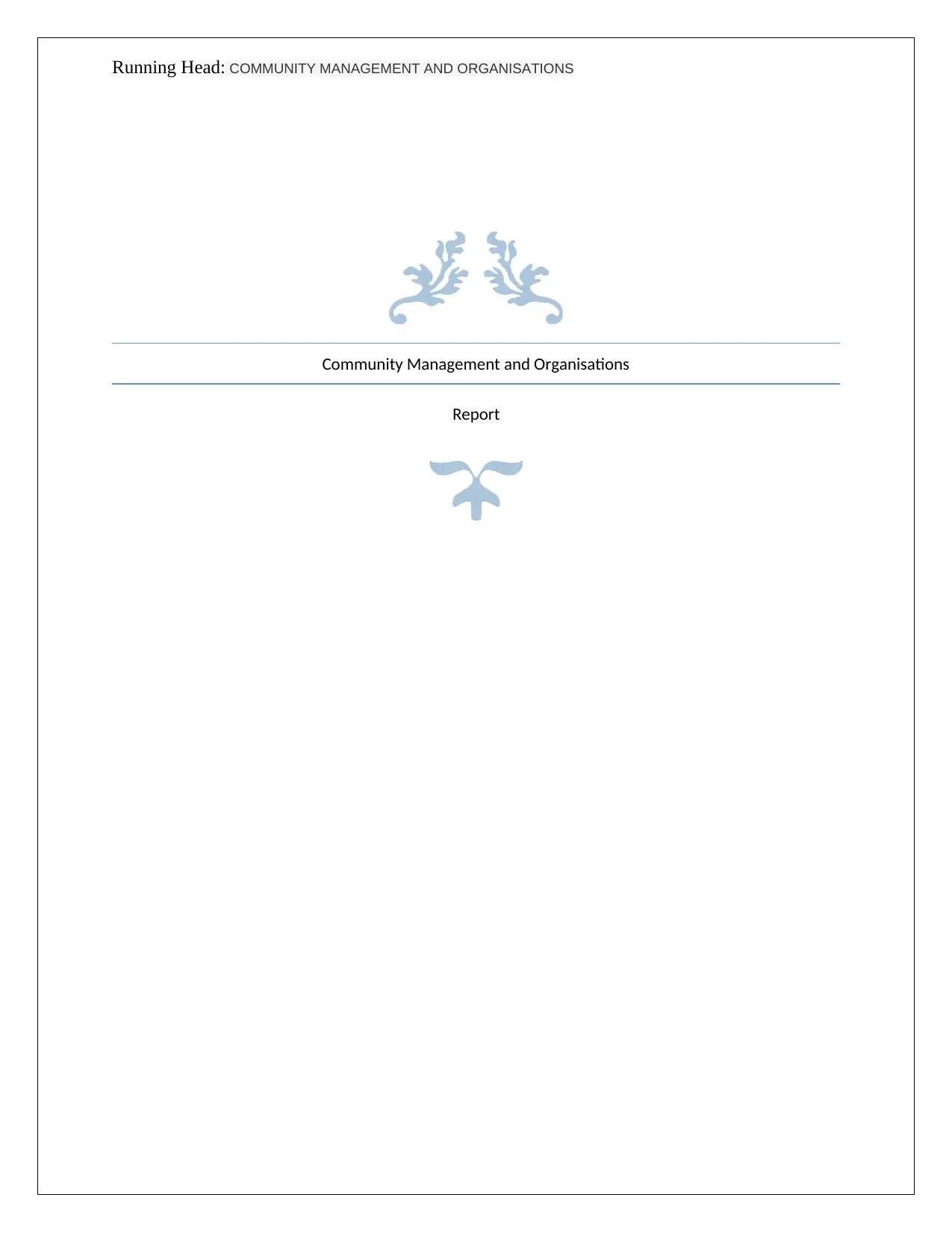
Running Head: COMMUNITY MANAGEMENT AND ORGANISATIONS
Community Management and Organisations
Report
Community Management and Organisations
Report
Paraphrase This Document
Need a fresh take? Get an instant paraphrase of this document with our AI Paraphraser
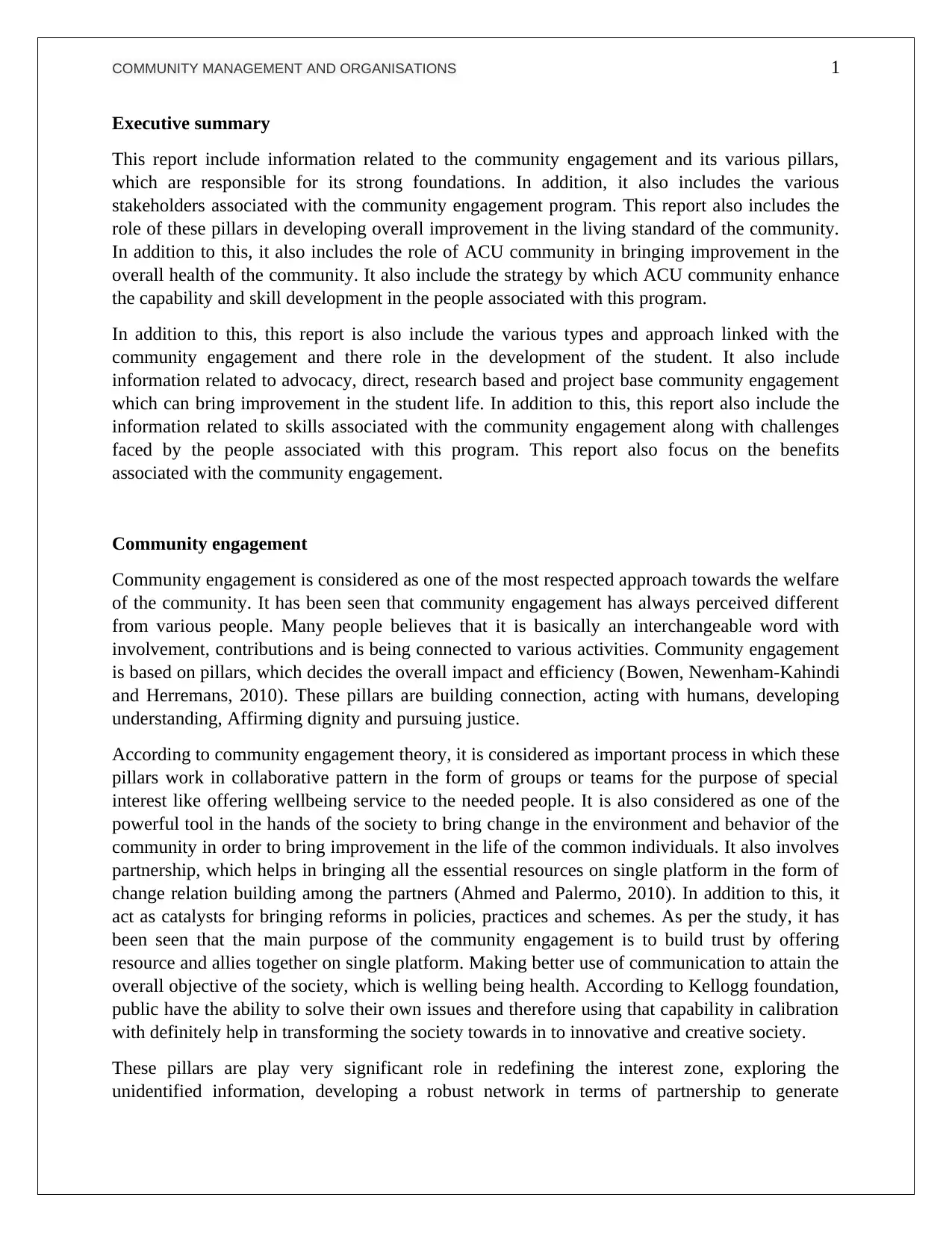
COMMUNITY MANAGEMENT AND ORGANISATIONS 1
Executive summary
This report include information related to the community engagement and its various pillars,
which are responsible for its strong foundations. In addition, it also includes the various
stakeholders associated with the community engagement program. This report also includes the
role of these pillars in developing overall improvement in the living standard of the community.
In addition to this, it also includes the role of ACU community in bringing improvement in the
overall health of the community. It also include the strategy by which ACU community enhance
the capability and skill development in the people associated with this program.
In addition to this, this report is also include the various types and approach linked with the
community engagement and there role in the development of the student. It also include
information related to advocacy, direct, research based and project base community engagement
which can bring improvement in the student life. In addition to this, this report also include the
information related to skills associated with the community engagement along with challenges
faced by the people associated with this program. This report also focus on the benefits
associated with the community engagement.
Community engagement
Community engagement is considered as one of the most respected approach towards the welfare
of the community. It has been seen that community engagement has always perceived different
from various people. Many people believes that it is basically an interchangeable word with
involvement, contributions and is being connected to various activities. Community engagement
is based on pillars, which decides the overall impact and efficiency (Bowen, Newenham-Kahindi
and Herremans, 2010). These pillars are building connection, acting with humans, developing
understanding, Affirming dignity and pursuing justice.
According to community engagement theory, it is considered as important process in which these
pillars work in collaborative pattern in the form of groups or teams for the purpose of special
interest like offering wellbeing service to the needed people. It is also considered as one of the
powerful tool in the hands of the society to bring change in the environment and behavior of the
community in order to bring improvement in the life of the common individuals. It also involves
partnership, which helps in bringing all the essential resources on single platform in the form of
change relation building among the partners (Ahmed and Palermo, 2010). In addition to this, it
act as catalysts for bringing reforms in policies, practices and schemes. As per the study, it has
been seen that the main purpose of the community engagement is to build trust by offering
resource and allies together on single platform. Making better use of communication to attain the
overall objective of the society, which is welling being health. According to Kellogg foundation,
public have the ability to solve their own issues and therefore using that capability in calibration
with definitely help in transforming the society towards in to innovative and creative society.
These pillars are play very significant role in redefining the interest zone, exploring the
unidentified information, developing a robust network in terms of partnership to generate
Executive summary
This report include information related to the community engagement and its various pillars,
which are responsible for its strong foundations. In addition, it also includes the various
stakeholders associated with the community engagement program. This report also includes the
role of these pillars in developing overall improvement in the living standard of the community.
In addition to this, it also includes the role of ACU community in bringing improvement in the
overall health of the community. It also include the strategy by which ACU community enhance
the capability and skill development in the people associated with this program.
In addition to this, this report is also include the various types and approach linked with the
community engagement and there role in the development of the student. It also include
information related to advocacy, direct, research based and project base community engagement
which can bring improvement in the student life. In addition to this, this report also include the
information related to skills associated with the community engagement along with challenges
faced by the people associated with this program. This report also focus on the benefits
associated with the community engagement.
Community engagement
Community engagement is considered as one of the most respected approach towards the welfare
of the community. It has been seen that community engagement has always perceived different
from various people. Many people believes that it is basically an interchangeable word with
involvement, contributions and is being connected to various activities. Community engagement
is based on pillars, which decides the overall impact and efficiency (Bowen, Newenham-Kahindi
and Herremans, 2010). These pillars are building connection, acting with humans, developing
understanding, Affirming dignity and pursuing justice.
According to community engagement theory, it is considered as important process in which these
pillars work in collaborative pattern in the form of groups or teams for the purpose of special
interest like offering wellbeing service to the needed people. It is also considered as one of the
powerful tool in the hands of the society to bring change in the environment and behavior of the
community in order to bring improvement in the life of the common individuals. It also involves
partnership, which helps in bringing all the essential resources on single platform in the form of
change relation building among the partners (Ahmed and Palermo, 2010). In addition to this, it
act as catalysts for bringing reforms in policies, practices and schemes. As per the study, it has
been seen that the main purpose of the community engagement is to build trust by offering
resource and allies together on single platform. Making better use of communication to attain the
overall objective of the society, which is welling being health. According to Kellogg foundation,
public have the ability to solve their own issues and therefore using that capability in calibration
with definitely help in transforming the society towards in to innovative and creative society.
These pillars are play very significant role in redefining the interest zone, exploring the
unidentified information, developing a robust network in terms of partnership to generate
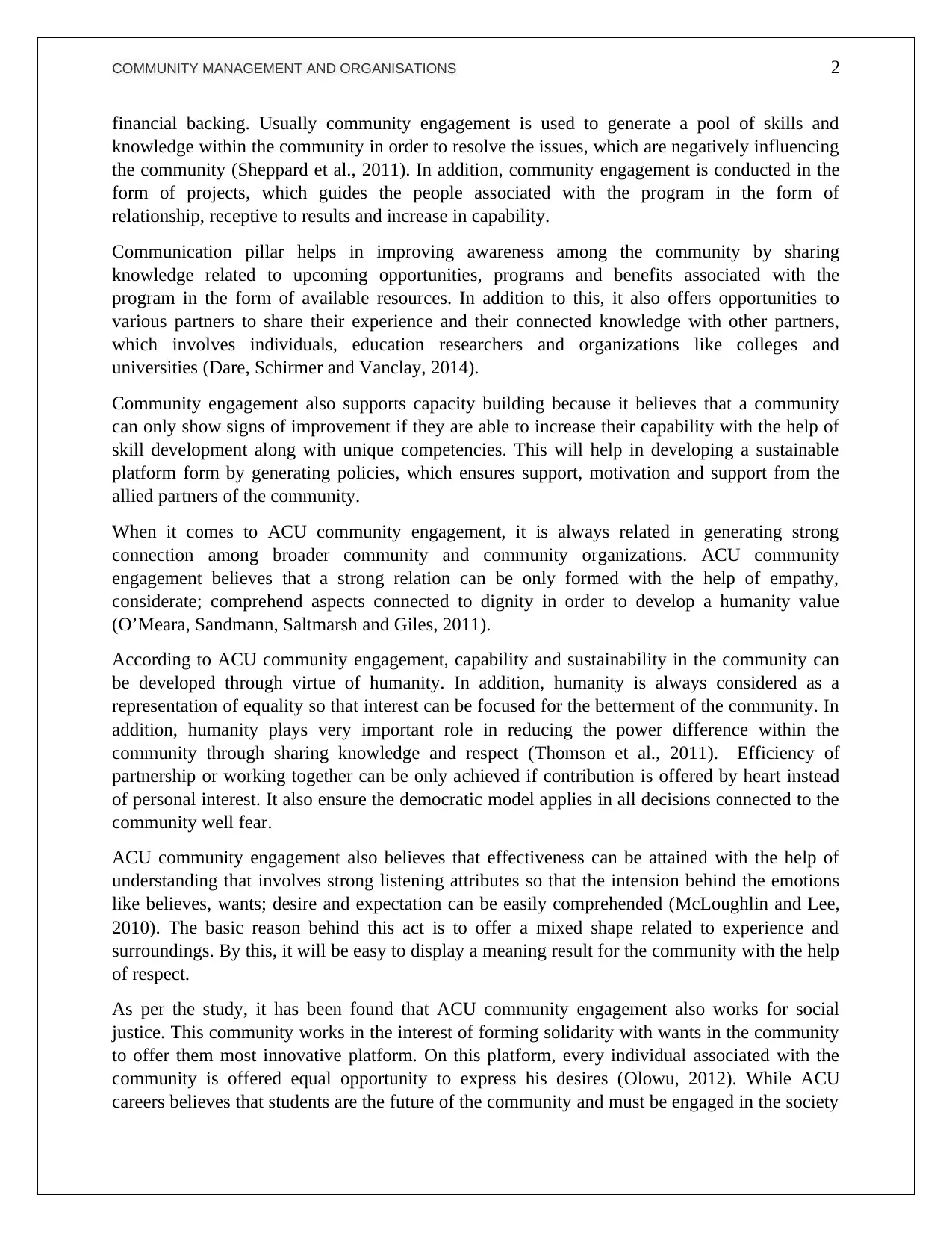
COMMUNITY MANAGEMENT AND ORGANISATIONS 2
financial backing. Usually community engagement is used to generate a pool of skills and
knowledge within the community in order to resolve the issues, which are negatively influencing
the community (Sheppard et al., 2011). In addition, community engagement is conducted in the
form of projects, which guides the people associated with the program in the form of
relationship, receptive to results and increase in capability.
Communication pillar helps in improving awareness among the community by sharing
knowledge related to upcoming opportunities, programs and benefits associated with the
program in the form of available resources. In addition to this, it also offers opportunities to
various partners to share their experience and their connected knowledge with other partners,
which involves individuals, education researchers and organizations like colleges and
universities (Dare, Schirmer and Vanclay, 2014).
Community engagement also supports capacity building because it believes that a community
can only show signs of improvement if they are able to increase their capability with the help of
skill development along with unique competencies. This will help in developing a sustainable
platform form by generating policies, which ensures support, motivation and support from the
allied partners of the community.
When it comes to ACU community engagement, it is always related in generating strong
connection among broader community and community organizations. ACU community
engagement believes that a strong relation can be only formed with the help of empathy,
considerate; comprehend aspects connected to dignity in order to develop a humanity value
(O’Meara, Sandmann, Saltmarsh and Giles, 2011).
According to ACU community engagement, capability and sustainability in the community can
be developed through virtue of humanity. In addition, humanity is always considered as a
representation of equality so that interest can be focused for the betterment of the community. In
addition, humanity plays very important role in reducing the power difference within the
community through sharing knowledge and respect (Thomson et al., 2011). Efficiency of
partnership or working together can be only achieved if contribution is offered by heart instead
of personal interest. It also ensure the democratic model applies in all decisions connected to the
community well fear.
ACU community engagement also believes that effectiveness can be attained with the help of
understanding that involves strong listening attributes so that the intension behind the emotions
like believes, wants; desire and expectation can be easily comprehended (McLoughlin and Lee,
2010). The basic reason behind this act is to offer a mixed shape related to experience and
surroundings. By this, it will be easy to display a meaning result for the community with the help
of respect.
As per the study, it has been found that ACU community engagement also works for social
justice. This community works in the interest of forming solidarity with wants in the community
to offer them most innovative platform. On this platform, every individual associated with the
community is offered equal opportunity to express his desires (Olowu, 2012). While ACU
careers believes that students are the future of the community and must be engaged in the society
financial backing. Usually community engagement is used to generate a pool of skills and
knowledge within the community in order to resolve the issues, which are negatively influencing
the community (Sheppard et al., 2011). In addition, community engagement is conducted in the
form of projects, which guides the people associated with the program in the form of
relationship, receptive to results and increase in capability.
Communication pillar helps in improving awareness among the community by sharing
knowledge related to upcoming opportunities, programs and benefits associated with the
program in the form of available resources. In addition to this, it also offers opportunities to
various partners to share their experience and their connected knowledge with other partners,
which involves individuals, education researchers and organizations like colleges and
universities (Dare, Schirmer and Vanclay, 2014).
Community engagement also supports capacity building because it believes that a community
can only show signs of improvement if they are able to increase their capability with the help of
skill development along with unique competencies. This will help in developing a sustainable
platform form by generating policies, which ensures support, motivation and support from the
allied partners of the community.
When it comes to ACU community engagement, it is always related in generating strong
connection among broader community and community organizations. ACU community
engagement believes that a strong relation can be only formed with the help of empathy,
considerate; comprehend aspects connected to dignity in order to develop a humanity value
(O’Meara, Sandmann, Saltmarsh and Giles, 2011).
According to ACU community engagement, capability and sustainability in the community can
be developed through virtue of humanity. In addition, humanity is always considered as a
representation of equality so that interest can be focused for the betterment of the community. In
addition, humanity plays very important role in reducing the power difference within the
community through sharing knowledge and respect (Thomson et al., 2011). Efficiency of
partnership or working together can be only achieved if contribution is offered by heart instead
of personal interest. It also ensure the democratic model applies in all decisions connected to the
community well fear.
ACU community engagement also believes that effectiveness can be attained with the help of
understanding that involves strong listening attributes so that the intension behind the emotions
like believes, wants; desire and expectation can be easily comprehended (McLoughlin and Lee,
2010). The basic reason behind this act is to offer a mixed shape related to experience and
surroundings. By this, it will be easy to display a meaning result for the community with the help
of respect.
As per the study, it has been found that ACU community engagement also works for social
justice. This community works in the interest of forming solidarity with wants in the community
to offer them most innovative platform. On this platform, every individual associated with the
community is offered equal opportunity to express his desires (Olowu, 2012). While ACU
careers believes that students are the future of the community and must be engaged in the society
⊘ This is a preview!⊘
Do you want full access?
Subscribe today to unlock all pages.

Trusted by 1+ million students worldwide
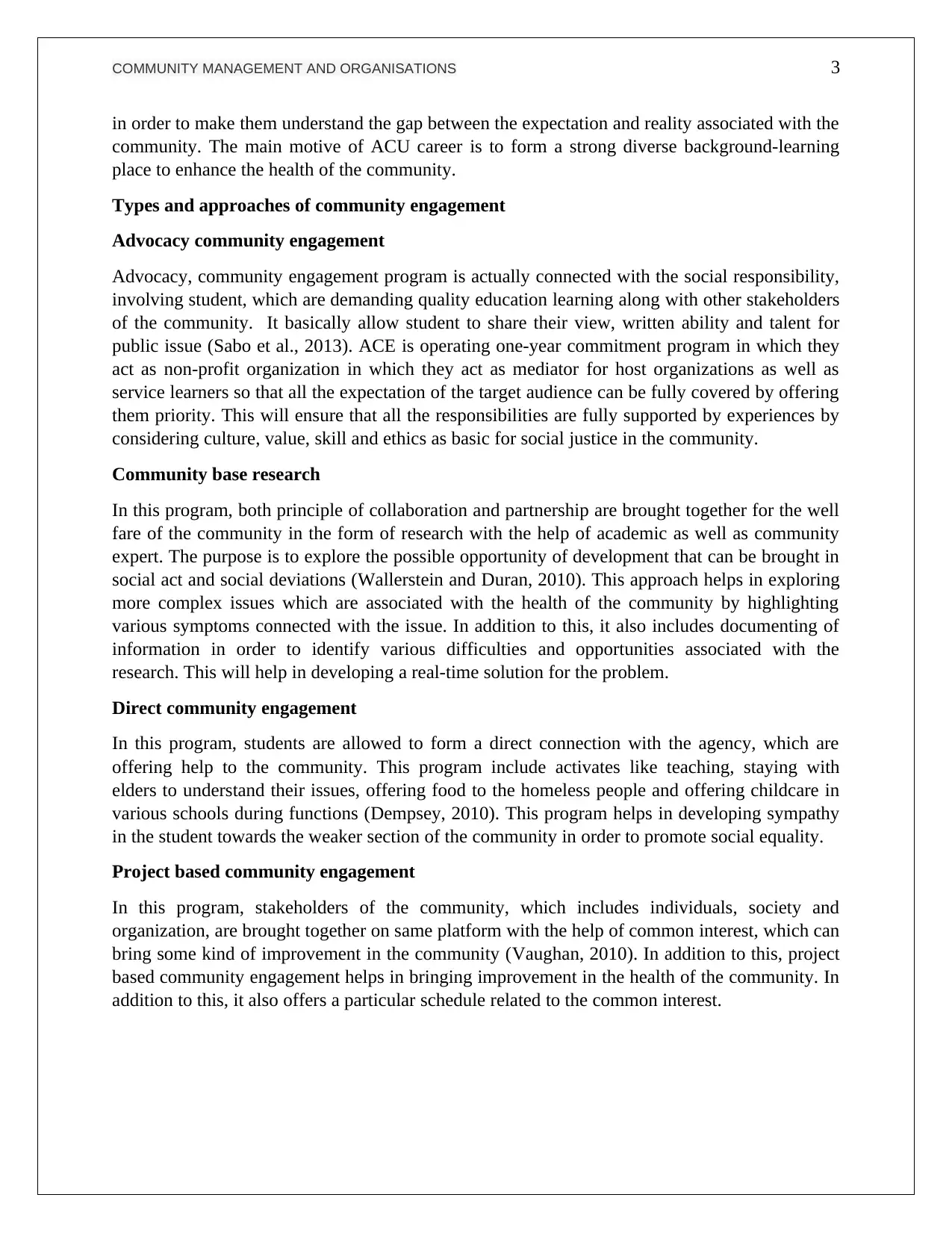
COMMUNITY MANAGEMENT AND ORGANISATIONS 3
in order to make them understand the gap between the expectation and reality associated with the
community. The main motive of ACU career is to form a strong diverse background-learning
place to enhance the health of the community.
Types and approaches of community engagement
Advocacy community engagement
Advocacy, community engagement program is actually connected with the social responsibility,
involving student, which are demanding quality education learning along with other stakeholders
of the community. It basically allow student to share their view, written ability and talent for
public issue (Sabo et al., 2013). ACE is operating one-year commitment program in which they
act as non-profit organization in which they act as mediator for host organizations as well as
service learners so that all the expectation of the target audience can be fully covered by offering
them priority. This will ensure that all the responsibilities are fully supported by experiences by
considering culture, value, skill and ethics as basic for social justice in the community.
Community base research
In this program, both principle of collaboration and partnership are brought together for the well
fare of the community in the form of research with the help of academic as well as community
expert. The purpose is to explore the possible opportunity of development that can be brought in
social act and social deviations (Wallerstein and Duran, 2010). This approach helps in exploring
more complex issues which are associated with the health of the community by highlighting
various symptoms connected with the issue. In addition to this, it also includes documenting of
information in order to identify various difficulties and opportunities associated with the
research. This will help in developing a real-time solution for the problem.
Direct community engagement
In this program, students are allowed to form a direct connection with the agency, which are
offering help to the community. This program include activates like teaching, staying with
elders to understand their issues, offering food to the homeless people and offering childcare in
various schools during functions (Dempsey, 2010). This program helps in developing sympathy
in the student towards the weaker section of the community in order to promote social equality.
Project based community engagement
In this program, stakeholders of the community, which includes individuals, society and
organization, are brought together on same platform with the help of common interest, which can
bring some kind of improvement in the community (Vaughan, 2010). In addition to this, project
based community engagement helps in bringing improvement in the health of the community. In
addition to this, it also offers a particular schedule related to the common interest.
in order to make them understand the gap between the expectation and reality associated with the
community. The main motive of ACU career is to form a strong diverse background-learning
place to enhance the health of the community.
Types and approaches of community engagement
Advocacy community engagement
Advocacy, community engagement program is actually connected with the social responsibility,
involving student, which are demanding quality education learning along with other stakeholders
of the community. It basically allow student to share their view, written ability and talent for
public issue (Sabo et al., 2013). ACE is operating one-year commitment program in which they
act as non-profit organization in which they act as mediator for host organizations as well as
service learners so that all the expectation of the target audience can be fully covered by offering
them priority. This will ensure that all the responsibilities are fully supported by experiences by
considering culture, value, skill and ethics as basic for social justice in the community.
Community base research
In this program, both principle of collaboration and partnership are brought together for the well
fare of the community in the form of research with the help of academic as well as community
expert. The purpose is to explore the possible opportunity of development that can be brought in
social act and social deviations (Wallerstein and Duran, 2010). This approach helps in exploring
more complex issues which are associated with the health of the community by highlighting
various symptoms connected with the issue. In addition to this, it also includes documenting of
information in order to identify various difficulties and opportunities associated with the
research. This will help in developing a real-time solution for the problem.
Direct community engagement
In this program, students are allowed to form a direct connection with the agency, which are
offering help to the community. This program include activates like teaching, staying with
elders to understand their issues, offering food to the homeless people and offering childcare in
various schools during functions (Dempsey, 2010). This program helps in developing sympathy
in the student towards the weaker section of the community in order to promote social equality.
Project based community engagement
In this program, stakeholders of the community, which includes individuals, society and
organization, are brought together on same platform with the help of common interest, which can
bring some kind of improvement in the community (Vaughan, 2010). In addition to this, project
based community engagement helps in bringing improvement in the health of the community. In
addition to this, it also offers a particular schedule related to the common interest.
Paraphrase This Document
Need a fresh take? Get an instant paraphrase of this document with our AI Paraphraser
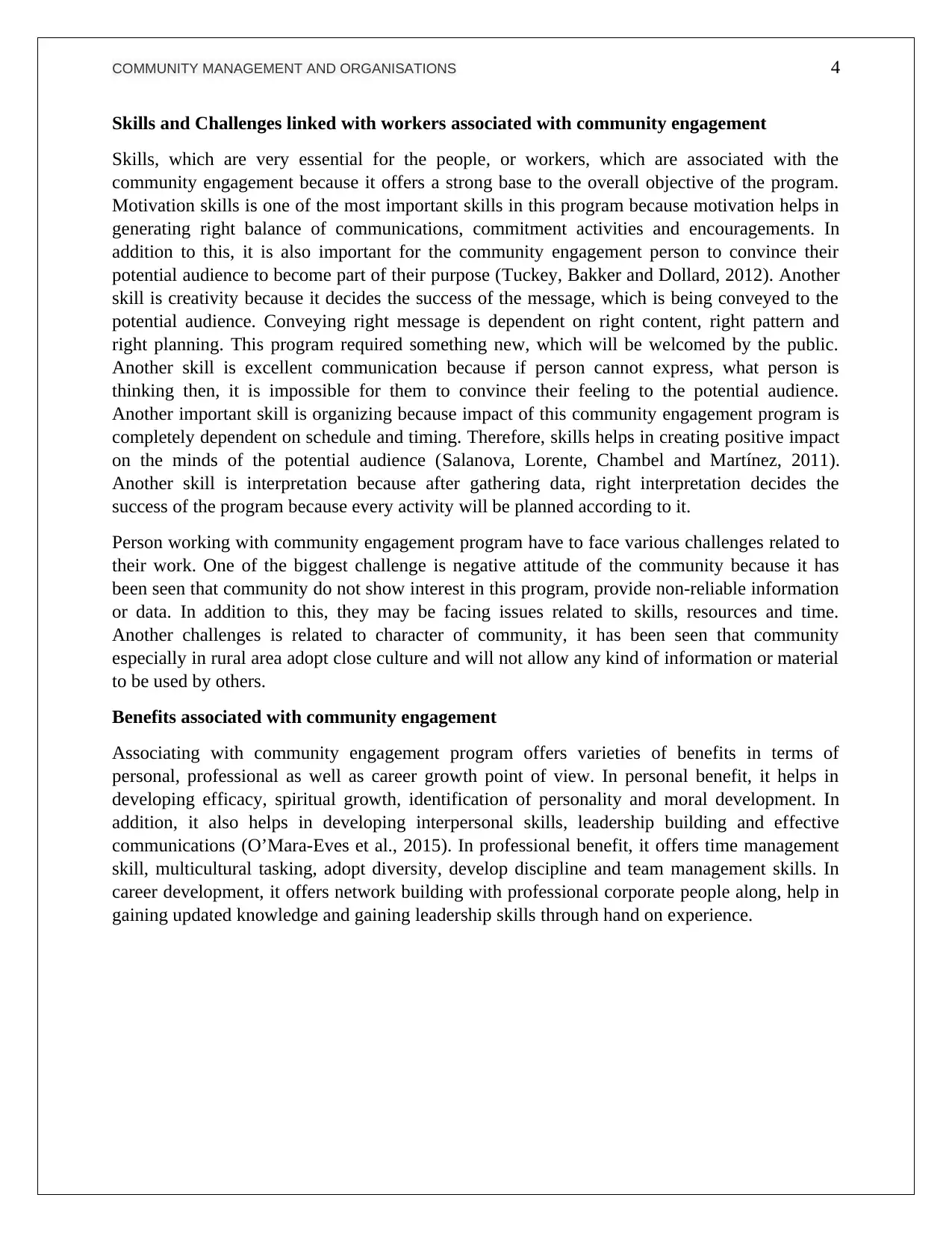
COMMUNITY MANAGEMENT AND ORGANISATIONS 4
Skills and Challenges linked with workers associated with community engagement
Skills, which are very essential for the people, or workers, which are associated with the
community engagement because it offers a strong base to the overall objective of the program.
Motivation skills is one of the most important skills in this program because motivation helps in
generating right balance of communications, commitment activities and encouragements. In
addition to this, it is also important for the community engagement person to convince their
potential audience to become part of their purpose (Tuckey, Bakker and Dollard, 2012). Another
skill is creativity because it decides the success of the message, which is being conveyed to the
potential audience. Conveying right message is dependent on right content, right pattern and
right planning. This program required something new, which will be welcomed by the public.
Another skill is excellent communication because if person cannot express, what person is
thinking then, it is impossible for them to convince their feeling to the potential audience.
Another important skill is organizing because impact of this community engagement program is
completely dependent on schedule and timing. Therefore, skills helps in creating positive impact
on the minds of the potential audience (Salanova, Lorente, Chambel and Martínez, 2011).
Another skill is interpretation because after gathering data, right interpretation decides the
success of the program because every activity will be planned according to it.
Person working with community engagement program have to face various challenges related to
their work. One of the biggest challenge is negative attitude of the community because it has
been seen that community do not show interest in this program, provide non-reliable information
or data. In addition to this, they may be facing issues related to skills, resources and time.
Another challenges is related to character of community, it has been seen that community
especially in rural area adopt close culture and will not allow any kind of information or material
to be used by others.
Benefits associated with community engagement
Associating with community engagement program offers varieties of benefits in terms of
personal, professional as well as career growth point of view. In personal benefit, it helps in
developing efficacy, spiritual growth, identification of personality and moral development. In
addition, it also helps in developing interpersonal skills, leadership building and effective
communications (O’Mara-Eves et al., 2015). In professional benefit, it offers time management
skill, multicultural tasking, adopt diversity, develop discipline and team management skills. In
career development, it offers network building with professional corporate people along, help in
gaining updated knowledge and gaining leadership skills through hand on experience.
Skills and Challenges linked with workers associated with community engagement
Skills, which are very essential for the people, or workers, which are associated with the
community engagement because it offers a strong base to the overall objective of the program.
Motivation skills is one of the most important skills in this program because motivation helps in
generating right balance of communications, commitment activities and encouragements. In
addition to this, it is also important for the community engagement person to convince their
potential audience to become part of their purpose (Tuckey, Bakker and Dollard, 2012). Another
skill is creativity because it decides the success of the message, which is being conveyed to the
potential audience. Conveying right message is dependent on right content, right pattern and
right planning. This program required something new, which will be welcomed by the public.
Another skill is excellent communication because if person cannot express, what person is
thinking then, it is impossible for them to convince their feeling to the potential audience.
Another important skill is organizing because impact of this community engagement program is
completely dependent on schedule and timing. Therefore, skills helps in creating positive impact
on the minds of the potential audience (Salanova, Lorente, Chambel and Martínez, 2011).
Another skill is interpretation because after gathering data, right interpretation decides the
success of the program because every activity will be planned according to it.
Person working with community engagement program have to face various challenges related to
their work. One of the biggest challenge is negative attitude of the community because it has
been seen that community do not show interest in this program, provide non-reliable information
or data. In addition to this, they may be facing issues related to skills, resources and time.
Another challenges is related to character of community, it has been seen that community
especially in rural area adopt close culture and will not allow any kind of information or material
to be used by others.
Benefits associated with community engagement
Associating with community engagement program offers varieties of benefits in terms of
personal, professional as well as career growth point of view. In personal benefit, it helps in
developing efficacy, spiritual growth, identification of personality and moral development. In
addition, it also helps in developing interpersonal skills, leadership building and effective
communications (O’Mara-Eves et al., 2015). In professional benefit, it offers time management
skill, multicultural tasking, adopt diversity, develop discipline and team management skills. In
career development, it offers network building with professional corporate people along, help in
gaining updated knowledge and gaining leadership skills through hand on experience.
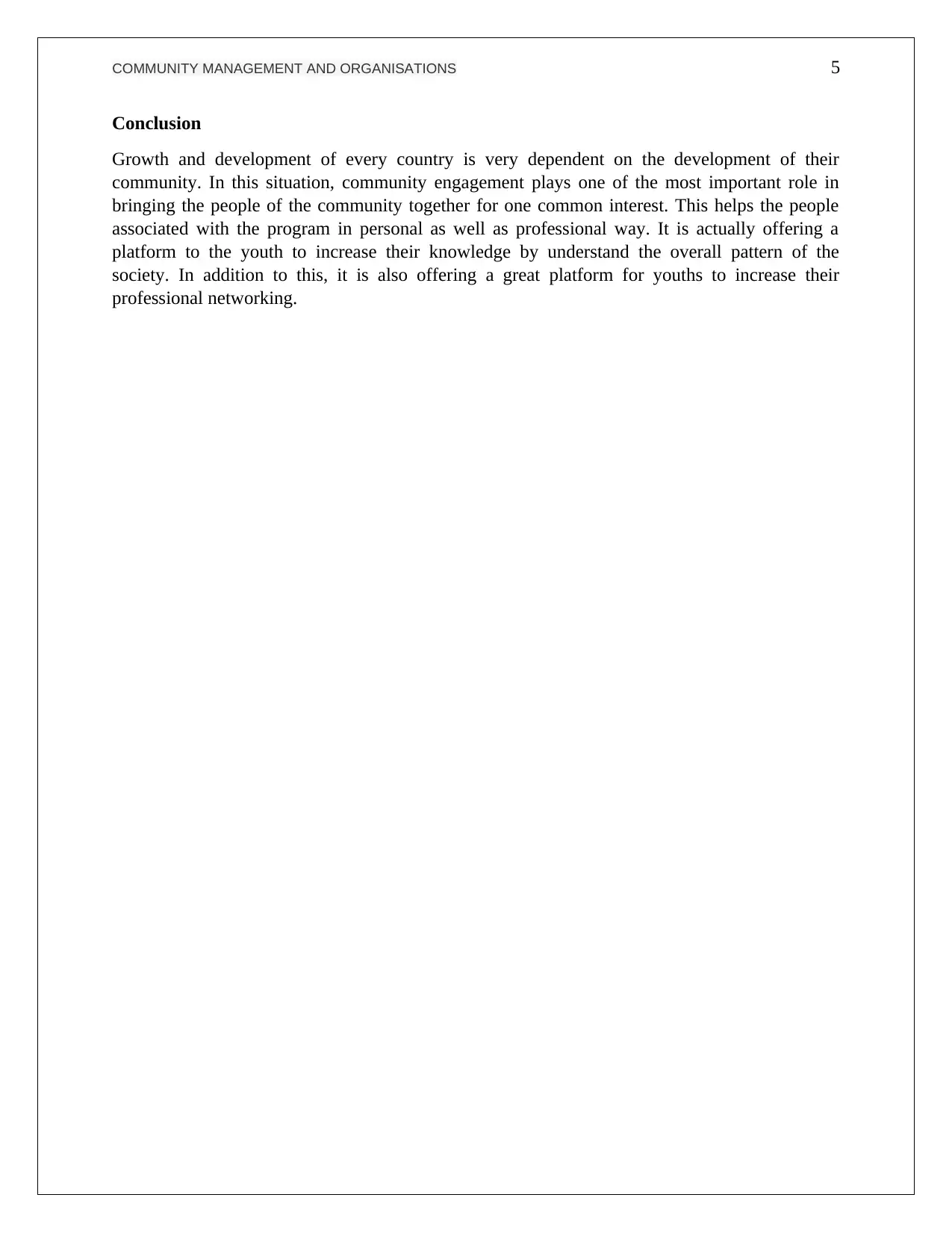
COMMUNITY MANAGEMENT AND ORGANISATIONS 5
Conclusion
Growth and development of every country is very dependent on the development of their
community. In this situation, community engagement plays one of the most important role in
bringing the people of the community together for one common interest. This helps the people
associated with the program in personal as well as professional way. It is actually offering a
platform to the youth to increase their knowledge by understand the overall pattern of the
society. In addition to this, it is also offering a great platform for youths to increase their
professional networking.
Conclusion
Growth and development of every country is very dependent on the development of their
community. In this situation, community engagement plays one of the most important role in
bringing the people of the community together for one common interest. This helps the people
associated with the program in personal as well as professional way. It is actually offering a
platform to the youth to increase their knowledge by understand the overall pattern of the
society. In addition to this, it is also offering a great platform for youths to increase their
professional networking.
⊘ This is a preview!⊘
Do you want full access?
Subscribe today to unlock all pages.

Trusted by 1+ million students worldwide
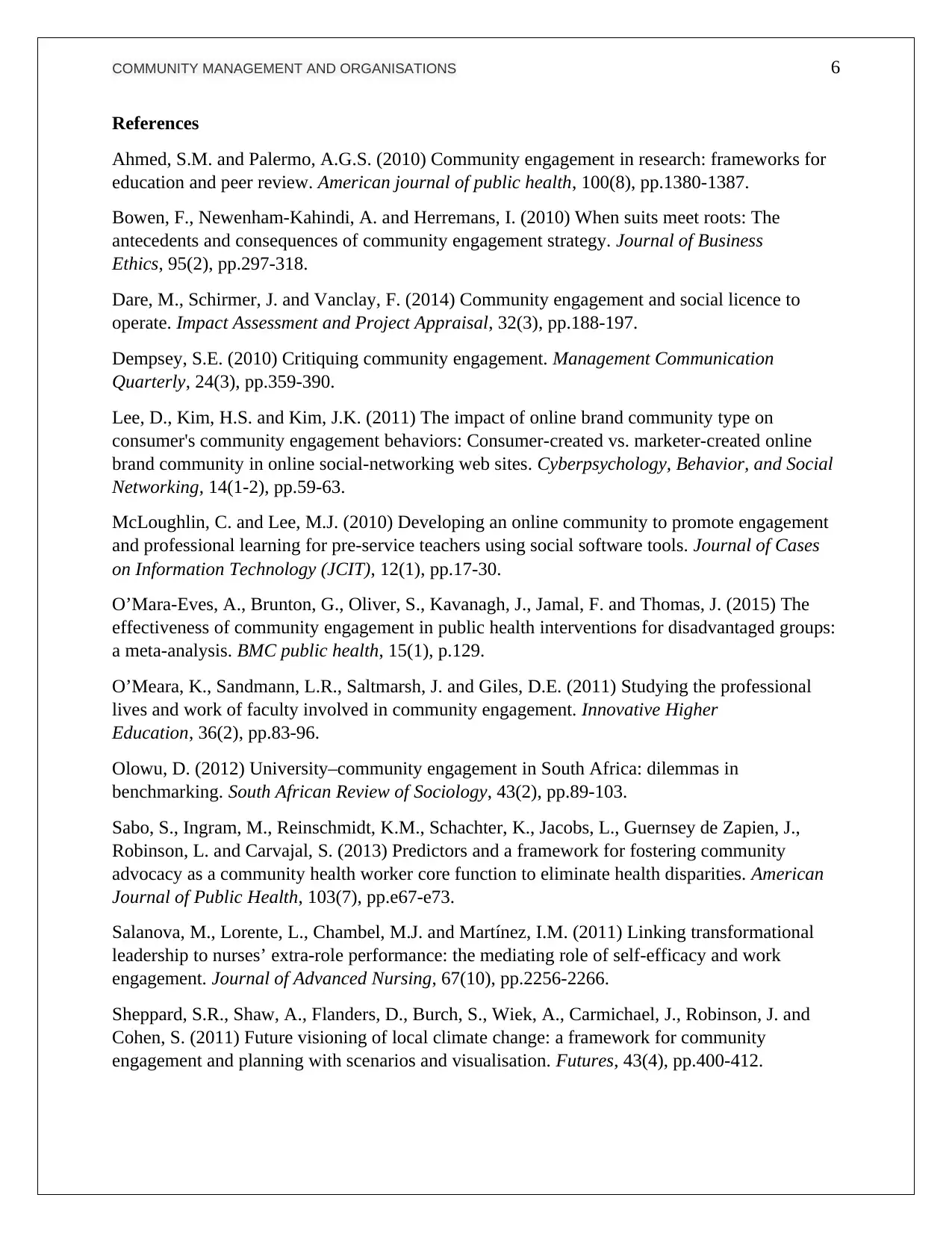
COMMUNITY MANAGEMENT AND ORGANISATIONS 6
References
Ahmed, S.M. and Palermo, A.G.S. (2010) Community engagement in research: frameworks for
education and peer review. American journal of public health, 100(8), pp.1380-1387.
Bowen, F., Newenham-Kahindi, A. and Herremans, I. (2010) When suits meet roots: The
antecedents and consequences of community engagement strategy. Journal of Business
Ethics, 95(2), pp.297-318.
Dare, M., Schirmer, J. and Vanclay, F. (2014) Community engagement and social licence to
operate. Impact Assessment and Project Appraisal, 32(3), pp.188-197.
Dempsey, S.E. (2010) Critiquing community engagement. Management Communication
Quarterly, 24(3), pp.359-390.
Lee, D., Kim, H.S. and Kim, J.K. (2011) The impact of online brand community type on
consumer's community engagement behaviors: Consumer-created vs. marketer-created online
brand community in online social-networking web sites. Cyberpsychology, Behavior, and Social
Networking, 14(1-2), pp.59-63.
McLoughlin, C. and Lee, M.J. (2010) Developing an online community to promote engagement
and professional learning for pre-service teachers using social software tools. Journal of Cases
on Information Technology (JCIT), 12(1), pp.17-30.
O’Mara-Eves, A., Brunton, G., Oliver, S., Kavanagh, J., Jamal, F. and Thomas, J. (2015) The
effectiveness of community engagement in public health interventions for disadvantaged groups:
a meta-analysis. BMC public health, 15(1), p.129.
O’Meara, K., Sandmann, L.R., Saltmarsh, J. and Giles, D.E. (2011) Studying the professional
lives and work of faculty involved in community engagement. Innovative Higher
Education, 36(2), pp.83-96.
Olowu, D. (2012) University–community engagement in South Africa: dilemmas in
benchmarking. South African Review of Sociology, 43(2), pp.89-103.
Sabo, S., Ingram, M., Reinschmidt, K.M., Schachter, K., Jacobs, L., Guernsey de Zapien, J.,
Robinson, L. and Carvajal, S. (2013) Predictors and a framework for fostering community
advocacy as a community health worker core function to eliminate health disparities. American
Journal of Public Health, 103(7), pp.e67-e73.
Salanova, M., Lorente, L., Chambel, M.J. and Martínez, I.M. (2011) Linking transformational
leadership to nurses’ extra‐role performance: the mediating role of self‐efficacy and work
engagement. Journal of Advanced Nursing, 67(10), pp.2256-2266.
Sheppard, S.R., Shaw, A., Flanders, D., Burch, S., Wiek, A., Carmichael, J., Robinson, J. and
Cohen, S. (2011) Future visioning of local climate change: a framework for community
engagement and planning with scenarios and visualisation. Futures, 43(4), pp.400-412.
References
Ahmed, S.M. and Palermo, A.G.S. (2010) Community engagement in research: frameworks for
education and peer review. American journal of public health, 100(8), pp.1380-1387.
Bowen, F., Newenham-Kahindi, A. and Herremans, I. (2010) When suits meet roots: The
antecedents and consequences of community engagement strategy. Journal of Business
Ethics, 95(2), pp.297-318.
Dare, M., Schirmer, J. and Vanclay, F. (2014) Community engagement and social licence to
operate. Impact Assessment and Project Appraisal, 32(3), pp.188-197.
Dempsey, S.E. (2010) Critiquing community engagement. Management Communication
Quarterly, 24(3), pp.359-390.
Lee, D., Kim, H.S. and Kim, J.K. (2011) The impact of online brand community type on
consumer's community engagement behaviors: Consumer-created vs. marketer-created online
brand community in online social-networking web sites. Cyberpsychology, Behavior, and Social
Networking, 14(1-2), pp.59-63.
McLoughlin, C. and Lee, M.J. (2010) Developing an online community to promote engagement
and professional learning for pre-service teachers using social software tools. Journal of Cases
on Information Technology (JCIT), 12(1), pp.17-30.
O’Mara-Eves, A., Brunton, G., Oliver, S., Kavanagh, J., Jamal, F. and Thomas, J. (2015) The
effectiveness of community engagement in public health interventions for disadvantaged groups:
a meta-analysis. BMC public health, 15(1), p.129.
O’Meara, K., Sandmann, L.R., Saltmarsh, J. and Giles, D.E. (2011) Studying the professional
lives and work of faculty involved in community engagement. Innovative Higher
Education, 36(2), pp.83-96.
Olowu, D. (2012) University–community engagement in South Africa: dilemmas in
benchmarking. South African Review of Sociology, 43(2), pp.89-103.
Sabo, S., Ingram, M., Reinschmidt, K.M., Schachter, K., Jacobs, L., Guernsey de Zapien, J.,
Robinson, L. and Carvajal, S. (2013) Predictors and a framework for fostering community
advocacy as a community health worker core function to eliminate health disparities. American
Journal of Public Health, 103(7), pp.e67-e73.
Salanova, M., Lorente, L., Chambel, M.J. and Martínez, I.M. (2011) Linking transformational
leadership to nurses’ extra‐role performance: the mediating role of self‐efficacy and work
engagement. Journal of Advanced Nursing, 67(10), pp.2256-2266.
Sheppard, S.R., Shaw, A., Flanders, D., Burch, S., Wiek, A., Carmichael, J., Robinson, J. and
Cohen, S. (2011) Future visioning of local climate change: a framework for community
engagement and planning with scenarios and visualisation. Futures, 43(4), pp.400-412.
Paraphrase This Document
Need a fresh take? Get an instant paraphrase of this document with our AI Paraphraser
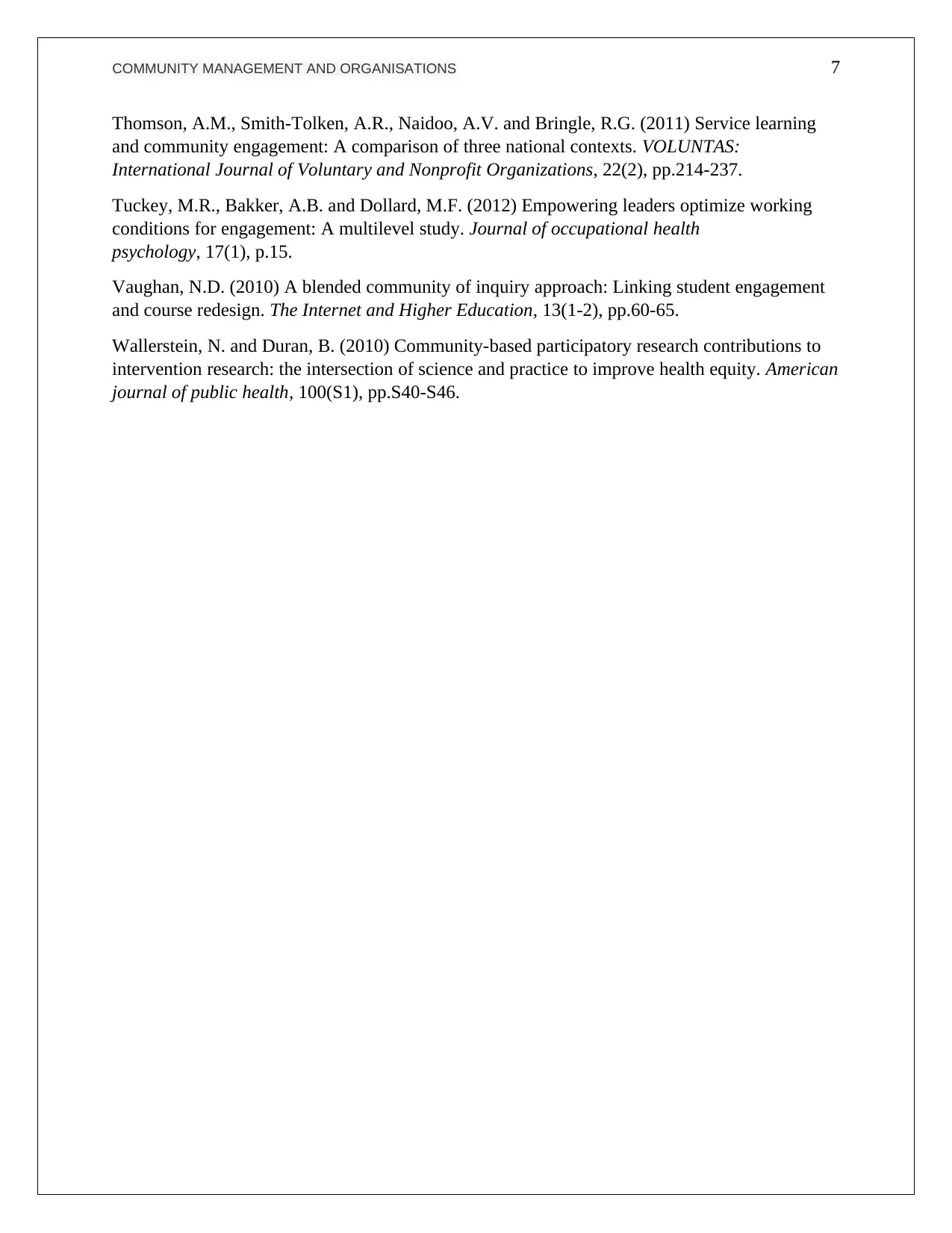
COMMUNITY MANAGEMENT AND ORGANISATIONS 7
Thomson, A.M., Smith-Tolken, A.R., Naidoo, A.V. and Bringle, R.G. (2011) Service learning
and community engagement: A comparison of three national contexts. VOLUNTAS:
International Journal of Voluntary and Nonprofit Organizations, 22(2), pp.214-237.
Tuckey, M.R., Bakker, A.B. and Dollard, M.F. (2012) Empowering leaders optimize working
conditions for engagement: A multilevel study. Journal of occupational health
psychology, 17(1), p.15.
Vaughan, N.D. (2010) A blended community of inquiry approach: Linking student engagement
and course redesign. The Internet and Higher Education, 13(1-2), pp.60-65.
Wallerstein, N. and Duran, B. (2010) Community-based participatory research contributions to
intervention research: the intersection of science and practice to improve health equity. American
journal of public health, 100(S1), pp.S40-S46.
Thomson, A.M., Smith-Tolken, A.R., Naidoo, A.V. and Bringle, R.G. (2011) Service learning
and community engagement: A comparison of three national contexts. VOLUNTAS:
International Journal of Voluntary and Nonprofit Organizations, 22(2), pp.214-237.
Tuckey, M.R., Bakker, A.B. and Dollard, M.F. (2012) Empowering leaders optimize working
conditions for engagement: A multilevel study. Journal of occupational health
psychology, 17(1), p.15.
Vaughan, N.D. (2010) A blended community of inquiry approach: Linking student engagement
and course redesign. The Internet and Higher Education, 13(1-2), pp.60-65.
Wallerstein, N. and Duran, B. (2010) Community-based participatory research contributions to
intervention research: the intersection of science and practice to improve health equity. American
journal of public health, 100(S1), pp.S40-S46.
1 out of 8
Related Documents
Your All-in-One AI-Powered Toolkit for Academic Success.
+13062052269
info@desklib.com
Available 24*7 on WhatsApp / Email
![[object Object]](/_next/static/media/star-bottom.7253800d.svg)
Unlock your academic potential
Copyright © 2020–2025 A2Z Services. All Rights Reserved. Developed and managed by ZUCOL.





